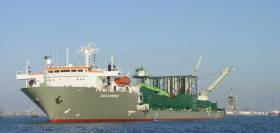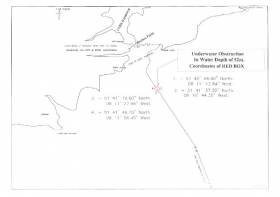Displaying items by tag: Kinsale Head Gas Field
#MarineNotice - PSE Kinsale Energy Limited advises that rock placement works will take place with an associated survey on the Kinsale Head Gas Export Pipeline off the South West Coast of Ireland from today (Wednesday 11 October).
The objective of these works is to stabilise two areas of the export pipeline. The works are expected to last for nine days.
Works will be carried out by the fallpipe rock placement vessel Seahorse (Callsign PCAP). The vessel will have a fallpipe deployed close to the seabed. Regular safety messages will be broadcast on VHF Channel 16.
All vessels, particularly those engaged in fishing, are requested to give the Seahorse a wide berth and keep a sharp lookout in the relevant areas. In case of any doubt, call the Seahorse on VHF Channel 16 and a safe course to follow will be given.
Full details of the work area are included in Marine Notice No 44 of 2017, a PDF of which is available to read or download HERE.
Mariners Beware Of Seabed Obstruction Off South Coast
#MarineWarning - PSE Kinsale Energy Ltd advises that, that following a recent survey of the Kinsale Head Gas Field pipeline, it has identified a possible seabed obstruction off the South Coast of Ireland.
The nature of the obstruction, south-east of Roches Point on the approach to Cork Harbour, may present a hazard to ground fishing equipment, so any fishing vessels operating within the area are advised to proceed with caution.
Details of co-ordinates of the affected area are included in Marine Notice No 26 of 2017, a PDF of which is available to read or download HERE.
Fastnet Oil Takes Option On 'Deep Kinsale Prospect'
#Oil - Fastnet Oil & Gas has executed its exclusive option agreement to farm into its Deep Kinsale Prospect beneath the Kinsale Head Gas Field.
The option agreement with Petronas subsidiary Kinsale Energy is confined to geological formations below 4,000 feet subsea. Fastnet will conduct a 3D seismic survey over 500 sq km in the Celtic Sea prospect by the end of the year as well as complete necessary geological and engineering studies.
The agreement also gives Fastnet an exclusive option to test the geologically similar Purbecko-Wealden reservoirs productive in Barryroe, a prospect that has proven a bounty for Providence Resources.
Fastnet chair Cathal Friel said: "We are delighted to have added an exclusive option to farm into and potentially drill the Deep Kinsale Prospect in 2014.
"It represents an attractive addition to our Irish portfolio as we have long held a belief that Deep Kinsale offers the potential to yield up another significant hydrocarbon discovery offshore Ireland. This belief has been further strengthened by the successful appraisal of Barryroe in 2012, which is geologically analogous to Deep Kinsale.
"We greatly look forward to working in close cooperation with our colleagues at Kinsale Energy, as we collectively seek to de-risk the prospect for drilling."
As previously reported on Afloat.ie, Fastnet Oil & Gas announced in December its plans to spend more than €20 million on the Celtic Sea's biggest ever seismic study on blocks off the south coast which were drilled in the 1980s and later abandoned.
New techniques in the oil industry are now allowing previously unviable resources to be extracted, as fellow prospectors Petrel Resources are planning to do off the Kerry coast.































































